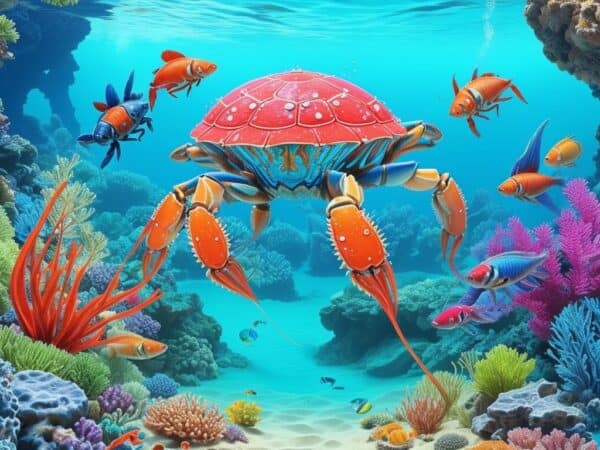Introduce freshwater crabs to your fish tank and watch them captivate! They don’t just look fantastic; they help balance the aquascape.
Scavenging for food, cleaning debris and controlling algae: crabs bring animation to your underwater world.
The great thing? There’s a species of freshwater crab that fits any water temperature. From tropical to temperate, pick and choose from vibrant colors and intricate body shapes.
Advantages of freshwater crabs: they enhance your aquarium’s appeal and promote harmony. They occupy different niches, diversifying the landscape.
Don’t miss out, add freshwater crabs for an engaging, visually stunning scene! They’ll benefit your underwater world and mesmerize you.
Benefits of Adding Freshwater Crabs to Your Fish Tank
Adding freshwater crabs to your fish tank can bring a range of advantages. These include:
- Increased Biodiversity: Introducing a new species creates a dynamic habitat, like natural aquatic environments.
- Natural Pest Control: They’ll consume organic matter, like algae and uneaten food.
- Visual Appeal: They come in different sizes, shapes, and colors.
But before adding these crabs, there are some things to consider:
- Check compatibility with existing fish.
- Provide hiding places, like caves or plants.
- Test and filter water quality regularly.
Preparing Your Fish Tank for Freshwater Crabs
Prepare your fish tank for freshwater crabs! It’s important to take a few steps for the health of your crustaceans and fish. Follow these guidelines to create a perfect habitat for your new aquatic buddies.
- Select a Tank: Choose a roomy tank that fits both the crabs and existing fish. Remember to consider the size of the crabs when picking the tank.
- Create Ideal Water Conditions: Freshwater crabs need certain water conditions. Monitor and test the pH level and temperature to keep them within acceptable ranges.
- Provide Hiding Places: Crabs like to hide. Include rocks, caves, and plants in your tank design for the crabs’ comfort and safety.
- Adjust the Filtration System: Some filtration systems may not suit freshwater crabs. Adjust your current system or get a new filter that gives the right amount of flow without harming the crabs.
- Introduce Fish: Research to make sure the fish won’t be too aggressive with the crabs. Choose tankmates that will coexist peacefully.
Fun Fact: Did you know some freshwater crab species can climb trees? The Vampire Crab (Geosesarma sp.) from Southeast Asia is known for its tree-climbing skills!
Choosing the Right Freshwater Crab Species
Selecting the ideal freshwater crab species for your fish tank can be a must. Different kinds have different care needs, so it’s important to pick one that suits your tank’s requirements. Take into account things like size, temperament and compatibility with other tankmates.
To help you make an informed decision, here’s a chart showing some common freshwater crab species and their main features:
| Species Name | Size (inches) | Temperament | Compatibility |
|---|---|---|---|
| Red Claw Crab | 2-4 | Semi-aggressive | Peaceful fish |
| Thai Micro Crab | 0.5 | Peaceful | Small inverts |
| Vampire Crab | 1.5 | Territorial | Semi-aggressive |
Be aware that while some crabs can live with fish, others may view them as food. Research the exact needs of each species before adding them to your fish tank.
In addition to considering the characteristics presented in the table, make sure that the water parameters of your tank are suitable for the chosen crab species. Some crabs prefer slightly brackish water, while others do well in freshwater. Keeping the correct water quality will benefit your pet crabs.
Pro Tip: Freshwater crabs are natural escapists! Make sure your aquarium has a secure lid to stop any unintended excursions by these curious animals.
Now that you have this info, you can confidently choose the right freshwater crab species that won’t only survive in your fish tank but also bring an interesting dynamic to your aquatic ecosystem. Enjoy crab-keeping!
Acquiring Freshwater Crabs
Freshwater Crabs are an amazing choice for fish tanks. They can bring a touch of nature and diversity. To get these interesting creatures, there are a few steps to follow:
- It is important to pick the correct species of freshwater crab that fits your tank’s conditions. Doing research on the types will help you make a wise decision. Popular options are the Thai Devil crab, Vampire crab, and Red Claw crab.
- Check that your tank is prepared before getting the freshwater crabs. They need particular water parameters like pH levels and temperature to survive. Give them plenty of hiding spots and the right substrate for their comfort.
- Then it’s time to get the freshwater crabs. It is important to buy them from reliable sellers, like trusted pet stores or online vendors who specialize in aquatic animals. This guarantees you healthy crabs that have been handled with care.
- When you have the freshwater crabs, you need to acclimate them slowly to their new environment. This involves introducing them to the water in their tank over a period of time. This permits them to adjust gradually and reduces stress.
You can find freshwater crabs in local places like rivers or streams. But it is not advised to take them from the wild because it puts the crab and ecosystem in danger.
Introducing Freshwater Crabs to Your Fish Tank
Introducing freshwater crabs to your fish tank can be a captivating experience! These creatures bring a new level of excitement and intrigue, creating a beautiful display for you and your fish. Here’s how to get started:
- Research the best crab species for your tank. Consider factors like water temperature, pH levels, and compatibility with other fish. Popular options include Thai micro crabs, red claw crabs, and fiddler crabs.
- Acclimate the crabs gradually. Float the bag in your tank for roughly 15 minutes, then carefully release them.
- Provide a suitable habitat and diet. Include rocks, caves, plants, and driftwood. Feed them algae wafers, vegetables, protein-rich foods, and crushed snail shells.
Add live plants or natural-looking decorations for extra charm. With consistent water quality, your crabs will thrive! Start today and create an unforgettable aquatic spectacle.
Maintaining the Fish Tank with Freshwater Crabs
Maintaining a freshwater crab tank needs attention to some important points!
- Water quality: Check water parameters like pH, ammonia, nitrite, and nitrate.
- Habitat setup: Make sure a secure hiding place with a suitable substrate and temperature is provided. Some species may need partially land-based habitats to behave naturally in captivity.
- Feeding: Feed a mix of crab pellets, algae wafers, vegetables, and small live or frozen foods.
- Tank maintenance: Clean the tank with regular siphoning and water changes. Observe filter efficiency.
- Compatibility: Consider compatibility with other tankmates.
- Monitoring: Watch for signs of illness or stress and seek vet care if needed.
- Salinity levels: Ensure the correct levels for crab health.
Conclusion
Freshwater crabs are a unique and colorful addition to any fish tank! They add enthusiasm and liveliness to the aquarium’s atmosphere, exciting both novice and experienced hobbyists. Adaptable to different environments, these crabs bring extraordinary benefits to any aquatic ecosystem.
They are essential for keeping the tank clean. Scavenging for food and algae, they prevent any buildup that could harm other inhabitants. Plus, their movement adds visual interest to the tank.
Freshwater crabs also have fascinating reproductive habits. Unlike most marine crustaceans, they don’t lay eggs. Instead, they carry their offspring under their abdomens until they hatch. Watching this unique nurturing behavior can be truly captivating.
In addition to their appeal and practical benefits, freshwater crabs hold cultural significance in many parts of the world. In Asia and South America, they symbolize luck and abundance. Having them in your fish tank can represent a cultural connection and bring depth to your appreciation of nature.
Frequently Asked Questions
1. Can I add freshwater crabs to my fish tank?
Yes, you can add freshwater crabs to your fish tank. However, it is important to research the specific type of crab you want to add and ensure that your tank is suitable for their needs.
2. What should I consider before adding freshwater crabs to my fish tank?
Before adding freshwater crabs, you should consider the size of your tank, compatibility with other tank inhabitants, water conditions, and the crabs’ diet and behavior. It is crucial to create a suitable environment to ensure the crabs’ well-being.
3. How many freshwater crabs can I add to my fish tank?
The number of freshwater crabs you can add to your fish tank depends on the tank size and the specific crab species. Some species are more territorial and require larger territories, while others can coexist in groups. It is essential to provide enough space for their growth and movement.
4. What do freshwater crabs eat?
Freshwater crabs are omnivores and have a diverse diet that includes plant matter, small invertebrates, and algae. To keep them healthy, it is recommended to provide a balanced diet that includes sinking pellets, frozen or live foods, and occasionally fresh vegetables.
5. How can I maintain the water conditions for freshwater crabs?
Freshwater crabs prefer slightly acidic to neutral water conditions with a temperature range of 75–82 °F (24–28 °C). Regular water testing and maintenance of appropriate pH, ammonia, nitrite, and nitrate levels are essential. Partial water changes should be performed regularly to keep the water clean and well-oxygenated.
6. Are there any specific tank requirements for freshwater crabs?
Yes, freshwater crabs have certain tank requirements. They need a suitable substrate, such as sand or gravel, which allows for burrowing, and plenty of hiding spots like caves or plants. Semi-aquatic areas should be provided to meet their natural behavior. It is also crucial to ensure there are no escape routes from the tank.

